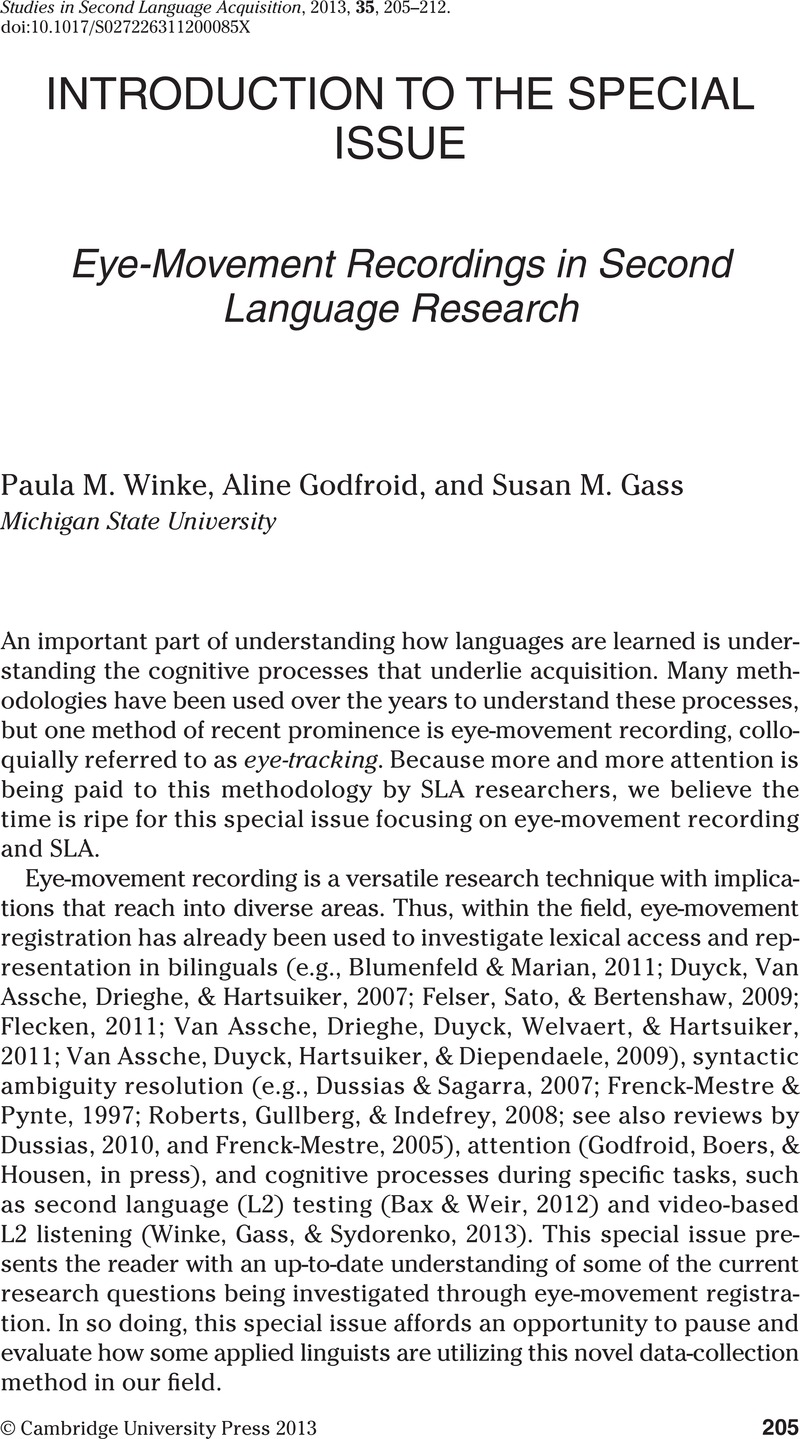Crossref Citations
This article has been cited by the following publications. This list is generated based on data provided by Crossref.
Winke, Paula
Gass, Susan
and
Sydorenko, Tetyana
2013.
Factors Influencing the Use of Captions by Foreign Language Learners: An Eye‐Tracking Study.
The Modern Language Journal,
Vol. 97,
Issue. 1,
p.
254.
Leow, Ronald P.
Grey, Sarah
Marijuan, Silvia
and
Moorman, Colleen
2014.
Concurrent data elicitation procedures, processes, and the early stages of L2 learning: A critical overview.
Second Language Research,
Vol. 30,
Issue. 2,
p.
111.
MONTERO PEREZ, MARIBEL
PETERS, ELKE
and
DESMET, PIET
2015.
Enhancing Vocabulary Learning Through Captioned Video: An Eye‐Tracking Study.
The Modern Language Journal,
Vol. 99,
Issue. 2,
p.
308.
Godfroid, Aline
and
Winke, Paula
2015.
Implicit and Explicit Learning of Languages.
Vol. 48,
Issue. ,
p.
325.
Cinkara, Emrah
and
Cabaroğlu, Neşe
2015.
Parallel Functioning Hypothesis to Explain Pronoun Resolution and Processing Load: Evidence from Eye-tracking.
Journal of Quantitative Linguistics,
Vol. 22,
Issue. 2,
p.
119.
Alptekin, Cem
and
Erçetin, Gülcan
2015.
Eye movements in reading span tasks to working memory functions and second language reading.
Eurasian Journal of Applied Linguistics,
Vol. 1,
Issue. 2,
p.
35.
Cintrón-Valentín, Myrna
and
Ellis, Nick C.
2015.
EXPLORING THE INTERFACE.
Studies in Second Language Acquisition,
Vol. 37,
Issue. 2,
p.
197.
Cintrón-Valentín, Myrna C.
and
Ellis, Nick C.
2016.
Salience in Second Language Acquisition: Physical Form, Learner Attention, and Instructional Focus.
Frontiers in Psychology,
Vol. 7,
Issue. ,
Loewen, Shawn
and
Plonsky, Luke
2016.
An A–Z of Applied Linguistics Research Methods.
p.
1.
2016.
References.
Language Learning,
Vol. 66,
Issue. S1,
p.
313.
Stickler, Ursula
and
Shi, Lijing
2017.
Eyetracking methodology in SCMC: A tool for empowering learning and teaching.
ReCALL,
Vol. 29,
Issue. 2,
p.
160.
Marijuan, Silvia
and
Sanz, Cristina
2017.
Technology-assisted L2 research in immersive contexts abroad.
System,
Vol. 71,
Issue. ,
p.
22.
Prichard, Caleb
and
Atkins, Andrew
2018.
L2 Readers' Global Processing and Selective Attention: An Eye Tracking Study.
TESOL Quarterly,
Vol. 52,
Issue. 2,
p.
445.
Mohamed, Ayman A.
2018.
EXPOSURE FREQUENCY IN L2 READING.
Studies in Second Language Acquisition,
Vol. 40,
Issue. 2,
p.
269.
GODFROID, ALINE
AHN, JIEUN
CHOI, INA
BALLARD, LAURA
CUI, YAQIONG
JOHNSTON, SUZANNE
LEE, SHINHYE
SARKAR, ABDHI
and
YOON, HYUNG-JO
2018.
Incidental vocabulary learning in a natural reading context: an eye-tracking study.
Bilingualism: Language and Cognition,
Vol. 21,
Issue. 3,
p.
563.
Loewen, Shawn
2018.
The Palgrave Handbook of Applied Linguistics Research Methodology.
p.
663.
许, 皖栋
2020.
Applying Eye-Tracking Technology into Language Assessment Research: Status Quo and Prospects.
Overseas English Testing: Pedagogy and Research,
Vol. 02,
Issue. 04,
p.
175.
Nassaji, Hossein
2020.
Assessing the effectiveness of interactional feedback for L2 acquisition: Issues and challenges.
Language Teaching,
Vol. 53,
Issue. 1,
p.
3.
Mackey, Alison
2020.
Interaction, Feedback and Task Research in Second Language Learning.
Hung, Yueh-Nu
Kuo, Hui-Yu
and
Liao, Shih-Chieh
2020.
Seeing What They See: Elementary EFL Students Reading Science Texts.
RELC Journal,
Vol. 51,
Issue. 3,
p.
397.



